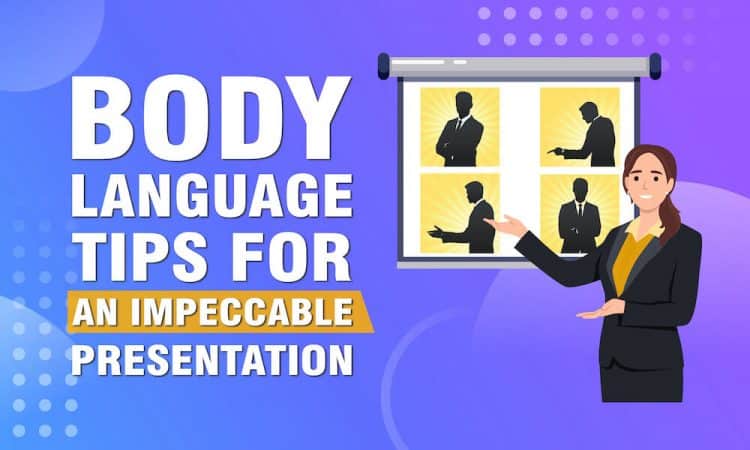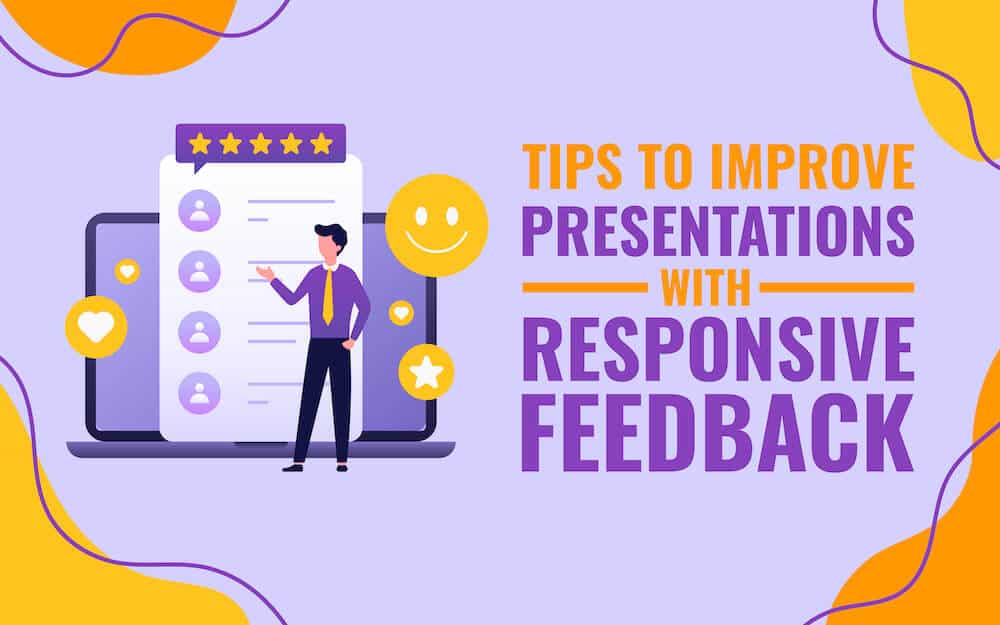
Do you agree your body language works as a communication tool, too, apart from your verbal communication?
Maybe? Maybe not?
Okay, let’s imagine a scenario. You are in for an important investor meeting. And this person dressed up in an expensive suit is sitting across from you. You start with the sales pitch confidently, but as you progress through the talk, you notice that the person isn’t maintaining eye contact well and is now sitting in a posture of crossed hands and legs.
How comfortable does that make you feel with going ahead?
Not a lot, right? He might not have spoken to you, but his body language communicated well enough that he had lost interest. And it wasn’t too difficult for you to understand as well.
That’s the potency of body language, communicating a whole world even though inaudible.
So, this article will cover elements that will help you keep this aspect in check for your next presentation.
What Do You Mean by Body Language in a Presentation?
Body language in your presentation will be how you and your body communicate without spoken words. It includes your hand gestures and movement, facial expressions, body postures, and movements, etc., and works both consciously and unconsciously.
It will tell everyone around you whether you are approachable, happy, excited, nervous, or comfortable.
For instance, you might say you are thrilled about sharing the content on screen, but you constantly tap your legs during the process. Your movement and gesture will convey that you are bumpy and nervous (at that moment) without you saying so.
Why is it Important in a Presentation?
Imagine a slouchy speaker or someone who sweats profusely (due to nervousness) while talking – do you think the presentation will be as impactful as it could be?
Body language is as important in a presentation as is the content. A bad delivery means you lose credibility as a speaker, and the audience might lose the incentive to listen to you or take your words seriously.
It will help you connect better with people and vice versa.
8 Tips to Create an Immaculate Body Language in Your Presentation
Let’s go through these elements that will help you sharpen your body language and use it to your advantage in the presentation.
1. Pose Like an Alpha – The Power Pose
In a study by psychologists, it was revealed that falling into and holding the alpha pose resulted in presenters feeling more powerful. According to the research, an open pose like that helps elevate testosterone (dominance and control) levels and lower cortisol (stress).
An appearance like that can make you feel in control and help deliver a confident presentation.
How to go about it?
- Stand in an upright posture with your shoulder back and feet – shoulder-width apart.
- Keep your arms open to make use of hand gestures comfortably.
- Face people as much as you can.
Pro Tip – Remember to tilt your entire body towards different sections of the audience to make everyone feel a part of your talk.
2. Be Solid with the Eye Contact
You want to build a quick connection with someone – make eye contact. When you do that as a presenter, your audience will feel more valued by you.
Psychology says that generally, when people lie, they avoid looking in the eye, so being conscious about maintaining eye contact will help you in multiple ways. People will trust you more, be attentive, and be more likely to respect you as a presenter.
It will also help you receive direct feedback (read the facial expressions) from the audience, and you can see whether they are really with you in your content.
How to go about it?
- In a larger audience, try to make eye contact with one person for 4 or more seconds before moving on to the second person and repeating the same.
- To cover your audience base properly, you can try maintaining eye contact in a Z formation. That is, starting with the back left in the audience, then moving to the back right, front right, and then front left – forming a Z. However, don’t repeat this pattern with the same set of people (again and again).
- In smaller groups, you can maintain eye contact for 9-10 seconds before breaking off. The similar pertains to when you are answering questions. Avoid looking for too long to avoid looking intense or staring.
3. Hand Gestures
You use hand and arm gestures to amplify what you are saying, a storytelling tool to enact something with your hands. It is the part of non-verbal communication that acts as a supporting element, accentuating the words.
Imagine standing like a dummy and just talking – how robotic as a presenter you would look? Using appropriate gestures will also make you seem more human-like, relaxed, and confident.
How to go about it?
- Remember not to go overboard with it. Use it sparingly with action words to keep it defined and focused.
- Maintain a neutral posture most of the time, i.e., hands on either side of the body.
- You can accentuate words by highlighting numbers and signs (symbolic gestures) with your hand, for example, showing 5 fingers for the number 5 or raising your hand as a sign in case of showing stop.
- Make use of descriptive gestures when you want to show movement. For example, if you want to show how little you were during a certain event, you can use your palm, face down, and a little distance from the floor to show that.
- Emphatic gestures help underscore emotion and conviction, for instance, folded hands to show pleading.
- When you want to show visual data, use your hands and eyes to guide people toward relevant things. You can use your legs and entire body movement as gestures too.
4. Body Movement
Moving around the stage shows the command and depicts you as someone who knows what they are saying. It demonstrates leadership and confidence. Moving around the stage will also help you include everyone in your talk and not just a specific section of the audience.
How to go about it?
- Don’t pace around a lot. It will distract your audience. Wait for at least 3 minutes before moving on to the next part of the stage.
- You can use the movement to highlight transitions in your presentation. So you can time your movements according to the changes in the topic.
- Don’t sway or rock your body when you stand at a place – either walk or stand still.
- When you ask questions or make an important point, move toward the people. Also, avoid turning your back toward people when you move, as it might disconnect them and come across as crude.
5. Facial Expressions
Facial expressions are important to add meaning and emphasis to the words you say. It helps interpret motives, intentions, and emotions, enabling people to respond better to the person.
You might be good as an orator but not so welcoming with your facial expressions. And it can make you look unwelcoming and distant to people, affecting connection and trust building.
Film yourself to filter out any artificial/unfriendly facial expressions and look more genuine. Like gestures, facial expressions, too, enhance your words.
How to go about it?
- You can raise your eyebrows to convey shock and frown to convey concern.
- Add a bit to your expressions when you address an audience of a larger size.
6. Voice
According to experts, one thumb rule for verbal and non-verbal communication is the 7-38-55 rule. The rule states that 7% of your communication constitutes words, 38% tone, and 55% body language. Combining these elements will help you create an engaging and powerful presentation.
How to go about it?
- Practice voice and pitch modulation.
- Gather your thoughts well to avoid mumbling and stuttering in the speech.
- Speak loudly, clearly, and confidently.
- Practice your speech well to be comfortable with it. You can also watch other presenter’s videos to learn from experts.
7. Mannerisms
Mannerisms are the common nervous habits most people have that might lessen the impact of the presentation or make people uncomfortable.
There might be habits you are not aware of, like constantly running your hands through your hair, blinking a lot, tapping your feet, or using filler words excessively.
Being mindful of these habits is imperative to deliver an impactful speech.
How to go about it?
- You can film yourself to find out if you have any such habits.
Once you know, practice every day to break it on a smaller scale. That way, you will be able to get rid of them when you finally present to the audience.
8. Breathing
Well, it’s not about spiritual practices or meditation, but breathing right actually reduces your stress levels and helps you appear composed. You don’t want to look all jittery and worked up in your presentation. Maintaining slow, steady breaths will help you avoid any nervous habit loop, slouchy postures, or excessive pacing.
It will also help you speak with the right voice modulation and pace and project your voice across the space appropriately.
How to go about it?
- Before starting your presentation, do breathing exercises to warm your voice, collect your thoughts, and calm yourself.
- Calm your breathing during the talk, and don’t take noisy breaths.
To Sum it Up
If you want to master your presentation, body language is one of the central puzzle pieces you need to get right. It will either enhance or detract from your core message.
Keeping in mind the above techniques will help you sharpen your presentation skill set. Having said that, you wouldn’t want to be too focused on standing right or breathing correctly in the middle of your talk.
So, it will be wise to practice these techniques well in advance to incorporate them comfortably into your demeanor.
Being confident and comfortable with your body language will convey a positive attitude to people and help them forge an instant connection with you as a speaker.



